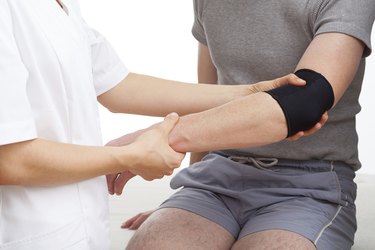
Tennis elbow most often develops in your dominant arm. If you're right-handed, you're more apt to develop this condition in your right elbow than your left. The reverse is true for someone who is left-handed. This isn't to say tennis elbow can't affect both elbows at the same time; it's just not as common.
Development
Video of the Day
Tennis elbow develops as a result of repeated muscle contractions within the forearm from continually twisting, straightening or raising the wrist. Any one of these motions can stress the tendons of the forearm, eventually leading to inflammation and even tears within the connective fiber near the outside of the elbow.
Video of the Day
Activity
Though its name comes from the sport of tennis, most occurrences of tennis elbow develop in people who don't play tennis at all. In fact, most often the condition afflicts the dominant arm of people in certain trades, including plumbers, painters, carpenters, chefs and butchers. But, some of these trades require the repetitive use of both hands, which can lead to tennis elbow in the dominant and non-dominant elbow. It's also possible for athletes who use both arms, such as basketball players who dribble with either hand or right-handed baseball pitchers who bat left-handed, to develop tennis elbow in both elbows.
Symptoms
If you develop tennis elbow, you'll likely suffer pain along the outside of the affected elbow. This pain is sometimes accompanied by weakness within the forearm, wrist and hand of the dominant arm. The pain also worsens and radiates into the back of the hand when people grasp an object or twist the wrist, explains the National Institutes of Health.
Treatment
Self-care typically helps improve tennis elbow. Resting the affected arm can reduce inflammation and associated pain, especially when you abstain from the activities that led to the overuse injury. You may also see improvement if you wrap the forearm and elbow and ice periodically throughout the day. You may even notice a lessening of pain by keeping the elbow elevated above your heart.
If self-care fails to provide results, you may need to work with a doctor or physical therapist to strengthen the area as well as help modify movements to avoid further stress to the muscles and joints of the arm. You may also need to wear a brace or strap to relieve stress on the forearm.
Recommendation
If you're experiencing pain in both elbows, talk to a doctor. What you're experiencing may not be tennis elbow at all. Instead, it could be something known as golfer's elbow. As with tennis elbow, repeated contractions of the muscles in the forearm can lead to pain within the elbow, but it's more isolated to the inside of this joint. Typing, chopping wood, lifting weights, raking and golfing are all known to contribute to this condition, especially when the pain is felt within both elbows.
Is this an emergency? If you are experiencing serious medical symptoms, please see the National Library of Medicine’s list of signs you need emergency medical attention or call 911.